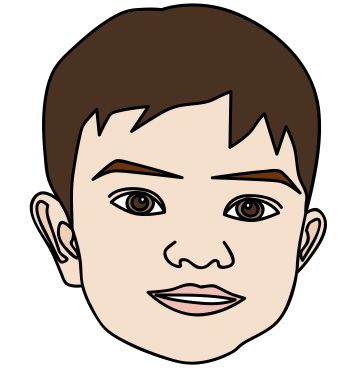 Simon is really excited about Halloween. For weeks, he’s been pretending to be scary monsters and spooky ghosts, giggling as he tries to scare his ABA therapy team. BOO! ROAR! He asks everyone what they’re going to be for Halloween and shares that he’s dressing up as Super Mario. Such sweet words to hear! Just four years ago, Simon was nearly non-verbal and had a lot of tantrums; and now, after a few years of ABA, he’s an enthusiastic talker with a great sense of humour. Here are the highlights of his story.
Simon is really excited about Halloween. For weeks, he’s been pretending to be scary monsters and spooky ghosts, giggling as he tries to scare his ABA therapy team. BOO! ROAR! He asks everyone what they’re going to be for Halloween and shares that he’s dressing up as Super Mario. Such sweet words to hear! Just four years ago, Simon was nearly non-verbal and had a lot of tantrums; and now, after a few years of ABA, he’s an enthusiastic talker with a great sense of humour. Here are the highlights of his story.
Simon was diagnosed with Autism Spectrum Disorder (ASD) when he was three years old. Shocked and saddened by the news, his parents began researching treatment options immediately. “ABA seemed to be the route with the most success and we began therapy about four months after his diagnosis,” say his parents. They hired Shayna Gaunt, director and founder of Kid Mechanix, to develop his ABA programs and lead the therapy team. “We chose her because she and her team are the best,” say Simon’s parents. “Their passion to help children is evident in everything they do. They are brilliant, professional, fast, effective, organized and efficient.”
When Simon started ABA, he could only utter a few singular words like Mama and Dada and, because he couldn’t express himself, had frequent meltdowns that were often aggressive. “Within 6 months of ABA, Simon could string two words together, such as ‘want latte,’ [meaning milk],” say his parents. “We were rejoicing at the small accomplishment! From there, the progress became more frequent, steadier and felt like leaps and bounds compared to where we had begun.” The main focus of treatment was on increasing communication skills in order to decrease tantrums. “We used motivation to teach language skills,” explains Shayna. “We set up opportunities for him to ask for highly preferred items and activities. Simon was much more tolerant and put in a lot more effort to speak when the item was of high value to him.” He also thrived when the team used visual cues to prompt and remind him to use his words.
The 15-20 hours of therapy a week he’s been receiving for more than three years have been hugely beneficial for the now 7-year-old. Simon’s tantrums have decreased as his functional language has increased; he can communicate most of his needs in full yet simple sentences. “He is even participating in joint and parallel play with some assistance,” say his parents. “He understands the difference between consequences of his negative behaviour versus the results he can achieve with his positive behaviour. He can also read independently (with emotion and expression!) at a grade level one year ahead of his peers.”
Being able to better communicate has also allowed Simon’s sense of humour to shine through. He’s a funny guy! “He often has me in stitches,” says Aileen, a registered behaviour technician who has worked with Simon for over two years. “For example, I was humming a tune recently – Simon loves music and loves to sing – and he suddenly said: ‘Put a sock on it, Aileen!’ He was grinning from ear to ear. We both laughed a lot.”
Very importantly, Simon seems to have a great time in therapy. A loving and affectionate boy, he welcomes his therapists at the door with a huge smile and a cute verbal greeting. “I always come with a bag full of surprises, such as his favourite books, light up toys and puzzles,” says therapist Aileen. “Right away, he asks to look in my bag; we empty it and then the fun ensues.” In sessions, the team taps into his passions, such as music, superheros and Halloween, to teach target skills, improve joint attention and keep him motivated. For example, Simon learned to follow eye gaze by retrieving his most preferred items from around the room. Since conversation skills are difficult for most students with ASD, we are teaching using his favourite subjects. He’s also showered with a lot of positive reinforcement. “Simon loves therapy because he knows that with each small thing he accomplishes in session, there is some type of reward, such as hugs, stickers, praise and preferred activities. He has transferred this to home life, too. He will approach us and say things like ‘I want to work for a super surprise.’ It’s amazing.” Although every student loves rewards, Kid Mechanix works really hard to fade these over time. Simon, once working for items after almost every correct response, now works for intermittent praise – he thinks high-10s are awesome – and interactive music breaks.
Since Simon is thriving with ABA, his family has decided to increase therapy hours. “We are absolutely delighted with Simon’s progress!” says Shayna. “With every passing week, his personality shines through more and more. He was once a shy little boy who wanted nothing to do with anyone or anything. Now, he can’t wait to interact with people. We are all so proud of him.”
Image by olovedog at FreeDigitalPhotos.net


Pingback: Simon’s Story Part 2: How ABA Has Helped Him Soar - How to ABA
Comments are closed.